Can skills-based hiring solve tech’s diversity problem? The data says yes.
“Experience matters. We hire old people. (And young people, too).” [1]
This bold 2021 job ad by tech startup RelevantDB quickly drew attention to tech’s long-standing diversity problem when it comes to hiring older workers.
However, tech’s diversity issue isn’t just about the lack of older workers. Data shows that the industry also tends to hire fewer women, Black and Latinx workers, and individuals with disabilities.
Despite recent contractions in the job market, tech is expected to expand more quickly than most other industries over the next few years. [2] This growth makes tech’s diversity issue urgent, as barriers to entry and a lack of inclusivity could become more ingrained if the issue is left unchecked.
Our take on solving this issue? Embracing skills-based hiring is a good place to start.
In this article, we dive into the tech industry’s lack of diversity and look at how a skills-based approach to recruitment can transform it.
What does tech’s diversity problem look like?
Tech often has a type. The “Silicon Valley bro” or “tech nerd” personas long associated with the tech industry are typically white, male, and young.
Here are some examples of tech’s diversity problem.
1. Lack of racial minorities
The majority of the US tech industry is made up of white or Asian workers, with Black and Latinx workers noticeably underrepresented.
According to an NAACP and Kapor Center analysis of company diversity reports from the 30 largest US-based tech companies, Black workers occupy just 3.7% of technical and 4% of executive leadership roles. This is despite Black talent making up 13% of the general labor force.
Underrepresentation has a butterfly effect on wages. Research by CBRE based on 2021 consensus and IPUMS data found that most Black and Hispanic tech professionals earn less than $100,000 (76.7% of Black and 75.4% of Hispanic workers). In comparison, only 46.6% of Asian tech workers and 64.9% of white tech workers earned below $100,000.
The murder of George Floyd in 2020 put a spotlight on the lack of racial diversity in tech, with many companies releasing statements and making public commitments to expand internal diversity, equity, and inclusion (DEI) efforts.
However, CNBC found that by 2023, DEI-related job postings had significantly decreased, and several Big Tech companies had let staff go and trimmed DEI programs.
Formal complaints and lawsuits against major tech companies highlight the industry’s racial diversity issues. For example, employees of the former ByteDance (the parent company of TikTok) have filed a racial discrimination and retaliation complaint against the company with the Equal Employment Opportunity Commission, while Google and Lumentum have been sued for racial discrimination.
2. Fewer women
Tech is also notorious for being a male-dominated sector. According to Women in Tech, at the end of 2023, women occupied only 35% of tech positions in the US.
Intersectionality compounds this issue. For example, only 2.4% of Google’s US workforce are Black women.
Once women get into tech, discrimination is an ongoing issue. New View Strategies spoke to 1,000 women in the tech industry, with one in three women reporting experiencing gender bias in the workplace. Almost half (46%) of these women said their employers aren’t actively prioritizing gender equality within their hiring or culture.
According to New View Strategies findings, the lack of gender diversity in tech appears to be a self-perpetuating problem. Forty-eight percent of respondents identified a lack of female role models as the biggest challenge for women entering the tech industry.
This is supported by the notable absence of women in more senior tech roles. For its research into women in tech, McKinsey interviewed 40 tech workers across various industries. It found that only 52 women are promoted to manager for every 100 men. This rate is significantly lower than the general average of 86 women for every 100 men.
3. Underrepresentation of older workers
The tech industry also struggles with age diversity, underrepresenting older workers.
Chris Cleveland wrote the job ad for RelevantDB at the start of this article. He explained why on the Hacker News forum. “I'm pushing 60 and I've attempted to interview for developer jobs over the last year. Got nowhere despite 40 years of experience. Getting really, really tired of this industry's attitude toward people like me.”
Data from PayScale’s compensation database shows that the median age of workers at the top 18 tech firms is 31. This median is especially low compared to the medians of other professionals – for example, real estate brokers and sales agents (the medians for these workers is 50.2)
Perhaps a lack of age diversity in tech results from the incorrect perception that older workers aren’t tech-savvy or an in-built preference for younger candidates from the digital native generations.
It’s likely the problem comes from the top. At 22 years old, Mark Zuckerberg said startups should hire young people with technical skills only: “Young people are just smarter.” (We wonder if 40-year-old Zuckerberg still stands by this.)
Tech’s ongoing issues with lacking age diversity – just like its lack of racial diversity – have led to lawsuits. For example, IBM is being sued for age discrimination, with former workers alleging there was a company-wide plan to reduce its older workforce and replace it with younger hires.
4. Barriers to access for employees with disabilities
Although not as heavily reported as race and gender discrimination, a lack of workers with disabilities in tech is also a significant issue.
While specific data from the tech industry is scarce, we know that 22.5% of people with a disability were employed in 2023 in the US. Despite this record number, the unemployment rate for people with disabilities was 7.2% – more than twice the rate for those without disabilities.
Why is this? In 2021, the Institute for Career Development and the New York Institute of Technology teamed up to study the challenges faced by individuals with disabilities (IWDs) entering the tech sector in New York.
Based on interviews with 40 people, the report identified several barriers for IWDs entering tech, including:
Barriers in the hiring process. For example, candidates with autism may not interview well despite having the necessary skills.
College degree requirements. Many IWDs attend alternative training programs that better accommodate their needs.
Lack of visibility. IWDs often hesitate to disclose their disabilities, leading to lower visibility.
Rachel Thomas, former director of the University of San Francisco Center for Applied Data Ethics, writes about the challenges candidates with health issues face when getting into tech. She explains, "The tech industry’s obsession with working ridiculously long hours is inaccessible to many disabled and ill people, for whom adequate rest is often not optional, or who may have regular doctor’s appointments, physical therapy, or tests."
Why diversity in tech matters
Beyond ethical and fairness considerations, there’s a strong business case for better diversity in tech. Diverse teams can transform a business, yet many employers in the tech sector are missing out on these benefits.
Here are some benefits of diversity in tech.
1. Increases innovation and better performance
Diverse teams lead to better innovation. A broad range of perspectives and experiences on a team fosters creativity. This is especially important in the highly competitive tech sector that demands innovative thinking and creative solutions to stay ahead.
This increased innovation has a direct impact on profitability. McKinsey’s Diversity Matters Even More report drew from publicly available data from 1,265 businesses in 23 countries. The data revealed that ethnically and gender-diverse teams are 39% more likely to have above-average financial returns.
2. Improves retention
Diversity also improves employee retention. Research by Great Place to Work found that employees who trust they’ll be treated fairly regardless of their personal characteristics are 5.4 times more likely to stay longer with their employer.
One explanation for this is that diversity supports an inclusive work culture, enhancing employee well-being.
In a survey by Boston Consulting Group involving 16,000 participants in 16 countries, 81% of employees who worked in an inclusive culture said they were happy in their jobs. This rate was three times higher compared with those who didn’t feel their work cultures were inclusive.
3. Is essential for representative technology
Diversity in tech also results in technology products that reflect all, not just some, consumers.
Dave Sherwood, Co-founder and CEO of BibliU, explains, “Having diversity in a tech team helps you achieve inclusive design. It’s better for reflecting real-world users, as well as uncovering biases and blind spots.”
This is especially evident in AI, which uses algorithms trained on input data. Biases in AI training data can produce biased results.
AI bias can have significant consequences. Professor Meredith Broussard, author of the nonfiction book More than a Glitch, highlights several racist, sexist, and ableist examples in her book, including:
A racist algorithm in facial recognition technology that led to the wrongful arrest of a man in Detroit for robbery
Mortgage approval algorithms that were 40-80% more likely to deny applications by borrowers of color
People working in AI and other emerging technologies must monitor for these biases. However, these biases are difficult to see for those who haven’t directly experienced them. The diversity of the people working on these applications and technologies reduces the likelihood of bias and results in more representative and ethical technology.
Author of Brotopia and executive producer of Bloomberg Technology, Emily Chang, puts it bluntly:
There's a great argument to be made that… overall we should have people of a variety of backgrounds building products that billions of people around the world are using. You guys are building the future. You're changing the way we live our lives, and so it makes zero sense for 95 percent of the decisions to be made by white men.
The best insights on HR and recruitment, delivered to your inbox.
Biweekly updates. No spam. Unsubscribe any time.
How skills-based hiring supports diversity in tech
For our 2024 State of Skills-Based Hiring in Tech report, we spoke to 119 employers and 81 employees across various countries, including the US, UK, Australia, Spain, and France. We asked them about their experiences with skills-based hiring – a process that focuses on a candidate's abilities and qualifications rather than their educational background or job history.
Our report found that 93% of tech employers using skills-based hiring reported improved diversity, compared to 84% of employers across all industries.
Let’s take a look at why.
1. Skills-based hiring prioritizes skills
Skills-based hiring puts skills at the center of the hiring process. This reduces the risk of conscious or unconscious bias affecting the process. Skills can be tested and measured objectively without consideration of candidates’ personal characteristics.
Strategies like skills-based assessments help with diversity. They’re more objective than resumes or employee referrals alone, which can perpetuate a lack of diversity – with some recruiters favoring candidates from similar backgrounds or elite schools or with employees recommending candidates similar to themselves.
Assessments are a large part of skills-based hiring and are ideal for gauging tech skills. Candidates can easily rattle off a list of tech skills on their resume. However, the only way to properly understand their tech abilities is to assess them with practical tests and exercises, like coding challenges or debugging exercises.
Assessments are also a great way to gain insights into candidates’ cognitive abilities and soft skills – objective criteria that help you find the best person for the job, regardless of their personal characteristics or background.
This approach isn’t just a win for employers. Candidates also prefer it.
Our 2024 report found that 58% of tech employees prefer skills-based hiring because it gives them a chance to show their skills.
Anna Williams, HR Director at Digital Silk, a web design agency, shared with us what happened when her company put skills at the center of the hiring process:
We prioritized SBH and observed a remarkable increase in workforce diversity – a clear 30% rise over one year. Skills-based hiring also had a positive impact on both the innovation and productivity levels, enhancing them by approximately 20% each.
2. A skills-first approach helps overcome educational barriers
Prioritizing candidates’ abilities and practical expertise over formal qualifications recognizes that university degrees aren’t the only pathway for acquiring essential skills.
This is especially important in the tech industry, where technology and the skills candidates need evolve rapidly. As a result, many tech workers acquire their expertise on the job or via alternative routes like online courses and bootcamps.
In recognition, many large tech companies – including IBM, Google, and Accenture – have moved towards skills-based hiring by removing degree requirements from job ads.
Tech employers can tap into more diverse talent pools by focusing on what candidates can actually do rather than a piece of paper. This levels the playing field for groups historically underrepresented in tech-focused programs or individuals who face barriers to access due to socioeconomic factors, geographic limitations, or other reasons.
For example, according to AnitaB.org, women received 21% of the total computer science degrees in the US. Only 2% of these went to Black and Latinx women, respectively.
The absence of a formal degree on their resume doesn’t mean candidates lack the skills the tech industry demands. A skills-first approach ensures these individuals aren’t overlooked and promotes greater diversity and equal access to opportunities in the tech sector.
3. Focusing on skills reduces unconscious bias
Bias – the tendency to prefer or reject certain candidates based on subjective factors unrelated to their qualifications, experience, or performance – significantly impacts hiring processes.
A good example is a 2021 joint study by the University of California Berkeley and the University of Chicago. In the most extensive study of its kind, researchers sent 83,000 applications from fictitious candidates with randomized races and genders to 108 Fortune 500 employers. On average, Black candidates received 21 fewer callbacks per 1,000 applications submitted than white candidates.
Bias is prevalent in tech hiring processes. In our 2024 report, 41% of candidates applying to tech roles reported experiencing conscious and unconscious bias during the hiring process. This is a 32% percentage increase on the industry-wide average of 31%.
In light of this, 49% of tech employees prefer skills-based hiring because it reduces hiring bias.
By focusing on candidates’ skills and using objective measures like skills assessments, tech employers can reduce the risk of bias influencing hiring outcomes.
4. Attracts – and retains – top candidates
Tech is a competitive hiring space, especially when recruiting top talent. A skills-based approach helps you attract the best and brightest candidates, regardless of their backgrounds.
Skills-based hiring demonstrates your commitment to diversity and inclusion. It shows your organization goes beyond diversity washing – simply paying lip service to diversity – and takes tangible steps to support DEI.
This is important to candidates. An 11-week study involving 178,862 job seekers found that candidates are willing to explore lower-paid roles to find more diverse companies.
Nahia Orduña is a technical leader at Amazon Web Services. Writing for Harvard Business Review, she explained the significance of DEI when choosing an employer:
I recently joined a tech company, and one of the critical criteria for me was how I would fit in as a foreigner and a female on a very technical team. I asked my hiring manager directly during the interview process, “How diverse is the team?” His answer was a deciding factor for me when considering whether to accept the position.
Skills-based hiring not only helps you attract top talent by demonstrating a commitment to DEI. It also helps you keep them. Our 2024 report found that 91% of employers reported improved retention after using skills-based hiring.
The broader impacts of diverse tech workforces
Increasing workforce diversity through skills-based hiring won’t just address underrepresentation. It can also tackle the broader workplace issues we discussed at the beginning of this article, like unequal pay for racial minorities, the mistreatment of women and older workers, and unrealistic expectations for workers with disabilities.
The varied perspectives diverse teams bring can start necessary conversations, challenge the status quo, and help promote fair practices.
It’s time for a tech hiring revolution
As the tech industry continues to expand, addressing the sector's lack of diversity is essential. Our research shows that skills-based hiring offers a clear path forward, enabling tech companies to tap into diverse talent pools.
With the future of tech roles poised for growth, the question is this: Are you ready to embrace skills-based hiring and pave the way for a more inclusive future in tech?
Wondering how to actually implement skills-based hiring? Our 90-day skills-based hiring implementation roadmap has you covered.
[1] Careers at RelevantDB, https://relevantdb.com/careers.html.
[2] Statista Research Department, “Projected employment percent change in the United States from 2022 to 2032, by major occupational groups,” Statista (2024) https://www.statista.com/statistics/218218/projected-employment-change-in-the-us-by-major-occupational-groups/.
You've scrolled this far
Why not try TestGorilla for free, and see what happens when you put skills first.




















